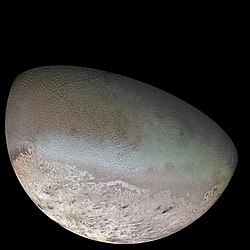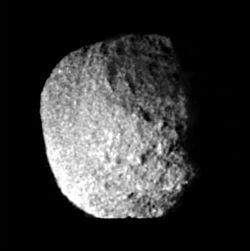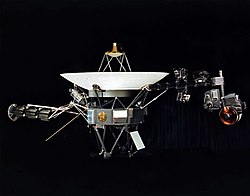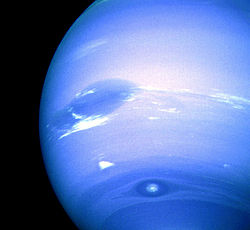Neptune
![]()
Neptune is the eighth and farthest planet from the Sun in the Solar System. It is an ice giant. It is the fourth-largest planet in the system.
 Neptune in true color[a] as captured by Voyager 2. Like Uranus, Neptune has a muted appearance; several storms can still be seen, such as the Great Dark Spot at the middle. | |||||||||||||
| Discovery[1] | |||||||||||||
|---|---|---|---|---|---|---|---|---|---|---|---|---|---|
| Discovered by | |||||||||||||
| Discovery date | September 23, 1846 | ||||||||||||
| Designations | |||||||||||||
| Pronunciation | US: /ˈnɛptuːn/ ( | ||||||||||||
Named after | Latin Neptunus, via French Neptune | ||||||||||||
| Adjectives | Neptunian (/nɛpˈtjuːniən/),[3] Poseidean[4] | ||||||||||||
| Orbital characteristics[9][b] | |||||||||||||
| Epoch J2000 | |||||||||||||
| Aphelion | 30.33 AU (4.54 billion km) | ||||||||||||
| Perihelion | 29.81 AU (4.46 billion km) | ||||||||||||
| 30.07 AU (4.50 billion km) | |||||||||||||
| Eccentricity | 0.008678 | ||||||||||||
| |||||||||||||
| 367.49 days[6] | |||||||||||||
Average orbital speed | 5.43 km/s[6] | ||||||||||||
| 259.883° | |||||||||||||
| Inclination | 1.770° to ecliptic 6.43° to Sun's equator 0.74° to invariable plane[7] | ||||||||||||
| 131.783° | |||||||||||||
| 2042-Sep-04[8] | |||||||||||||
| 273.187° | |||||||||||||
| Known satellites | 16 | ||||||||||||
| Physical characteristics | |||||||||||||
Mean radius | 24,622±19 km[10][c] | ||||||||||||
Equatorial radius | 24,764±15 km[10][c] 3.883 Earths | ||||||||||||
Polar radius | 24,341±30 km[10][c] 3.829 Earths | ||||||||||||
| Flattening | 0.0171±0.0013 | ||||||||||||
| 7.6187×109 km2[11][c] 14.98 Earths | |||||||||||||
| Volume | 6.253×1013 km3[6][c] 57.74 Earths | ||||||||||||
| Mass | 1.02413×1026 kg[6] 17.147 Earths 5.15×10−5 Suns | ||||||||||||
Mean density | 1.638 g/cm3[6][d] | ||||||||||||
| 11.15 m/s2[6][c] 1.14 g | |||||||||||||
| 0.23[12] (estimate) | |||||||||||||
| 23.5 km/s[6][c] | |||||||||||||
| 0.67125 d 16 h 6 m 36 s[5] | |||||||||||||
Sidereal rotation period | 0.6713 day[6] 16 h 6 min 36 s | ||||||||||||
Equatorial rotation velocity | 2.68 km/s (9,650 km/h) | ||||||||||||
| 28.32° (to orbit)[6] | |||||||||||||
North pole right ascension | 19h 57m 20s[10] 299.3° | ||||||||||||
North pole declination | 42.950°[10] | ||||||||||||
| Albedo | 0.290 (bond[13] [13] | ||||||||||||
| |||||||||||||
| 7.67[15] to 8.00[15] | |||||||||||||
| −6.9[16] | |||||||||||||
| 2.2–2.4″[6][17] | |||||||||||||
| Atmosphere[6] | |||||||||||||
| 19.7±0.6 km | |||||||||||||
| Composition by volume | |||||||||||||
Neptune's mass is 17 times Earth's mass and a little bit more than Uranus' mass. Neptune is denser and smaller than Uranus. Because of its greater mass, Neptune's gravity makes its atmosphere smaller and denser.
It was named after the Roman god of the sea, Neptune. Neptune's astronomical symbol is ♆, the trident of the god Neptune.
Neptune's atmosphere is mostly hydrogen and helium. It also contains small amounts of methane which makes the planet appear blue.[18][19][20] Neptune's blue color is similar, but slightly darker, than the color of Uranus. Neptune also has the strongest winds of any planet in the Solar System, as high as 2,100 km/h or 1,300 mph.[21]
Urbain Le Verrier and John Couch Adams were the astronomers who discovered Neptune. Neptune was not discovered using a telescope. It was the first planet to be discovered using mathematics. In 1821, astronomers saw that Uranus' orbit was different from what they expected. Another nearby planet's mass was changing Uranus' orbit. They found Neptune was the cause.
Voyager 2 visited Neptune on August 25, 1989. It was the only spacecraft to visit the planet. Neptune used to have a huge storm known as the "Great Dark Spot". Voyager 2 discovered the spot in 1989. The dark spot was not seen in 1994, but new spots were found since then. It is not known why the dark spot disappeared. Visits by other space probes have been planned.
Neptune has five rings surrounding it. However, the rings are hard to see from Earth.
History

Discovery
Galileo Galilei was the first person to see Neptune.[22] He saw it on December 28, 1612 and January 27, 1613.[22] His drawings showed the points where Neptune is placed, it is near Jupiter.[22] But Galileo was not credited for the discovery. He thought Neptune was a "fixed star" instead of a planet. Because Neptune moved slowly across the sky, Galileo's small telescope was not strong enough to see that Neptune was a planet.[23]
In 1821, Alexis Bouvard published the astronomical tables of the orbit of Uranus.[24][25] Later observations showed that Uranus was orbiting in an irregular way.[26] Some astronomers thought this was caused by another large planet.[26] In 1843, John Couch Adams calculated the orbit of an eighth planet that could possibly affect the orbit of Uranus. He sent his calculations to Sir George Airy, the Astronomer Royal. George Airy asked Adams for an explanation.[27] In 1846, Urbain Le Verrier made his own calculations but also failed to get much attention from French astronomers.[25][28] Airy saw his calculations and encouraged James Challis to search for the planet. Challis began his search in July 1846. Meanwhile, Le Verrier had convinced Johann Gottfried Galle to search for the planet.[28]
Heinrich d'Arrest, a student at the Berlin Observatory, suggested that a newly drawn map of the sky in the region of Le Verrier's predicted area could be compared with the current sky.[28] This map was needed to look for the change of position of a planet, compared to a fixed star. Neptune was discovered the same night on September 23, 1846.[29] It was found 1° from where Le Verrier had thought it would be. It was about 1.5° from Adams' prediction.[30] Challis later found out that he had seen the planet twice in August. He did not recognize it at the time because of his careless work approach.[28] Neptune became the first planet to be discovered by mathematical calculations instead of a telescope.[31]
Crediting and naming
When Neptune was discovered, the French and the British could not agree on who would get credit for the discovery. Later, an international agreement decided that both Le Verrier and Adams deserved credit. However, historians reviewed the topic after the rediscovery in 1998 of the "Neptune papers" (historical documents from the Royal Greenwich Observatory). It had seemingly been stolen by astronomer Olin Eggen for almost 30 years. It was only found again (in his ownership) shortly after his death.[32] After looking at the documents, some historians now think that Adams does not deserve equal credit with Le Verrier.[33]
Shortly after its discovery, Neptune was temporarily called "the planet exterior to Uranus" or "Le Verrier's planet". The first suggestion for a name came from Galle. He proposed the name Janus. In England, Challis suggested the name Oceanus.[34] In France, Arago suggested that the new planet be called Leverrier, but a lot of people outside France disagreed with this. French almanacs quickly reintroduced the name Herschel for Uranus and Leverrier for Neptune.[27]
Meanwhile, Adams suggested changing the name Georgian to Uranus, while Le Verrier (through the Board of Longitude) suggested Neptune for the new planet. Struve supported the name Neptune on December 29, 1846, to the Saint Petersburg Academy of Sciences.[35] Soon, Neptune was internationally agreed as the official name for the new planet. In Roman mythology, Neptune was the god of the sea, identified with the Greek god, Poseidon.[36][37][38] Neptune's astrological symbol is Neptune's trident (♆).[39]
Structure
Mass and composition
Neptune's mass is between that of the Earth and the largest gas giants.[40] Neptune is the fourth largest planet in the Solar System and the third most massive.[31] Neptune is 17 times the mass of Earth, but just 1⁄18 the mass of Jupiter.[41] Neptune is a little bit more massive than Uranus, though Neptune is denser and smaller in size than Uranus.[31] Neptune and Uranus are often considered a part of "ice giants" (a sub-class of gas giants).[31][42] They are smaller in size than Jupiter and Saturn, and have different compositions. To search extrasolar planets, Neptune has been used as a reference to compare the size and structure of other discovered planets. Some discovered planets that have similar masses like Neptune are often called "Neptunes".[43]
The atmosphere of Neptune is made up mostly of hydrogen, with a smaller amount of helium. A tiny amount of methane was also detected in the atmosphere. The methane gives Neptune its blue color.[44][45] The color of Neptune is similar, but slightly darker, than the color of Uranus.[45]
Because of Neptune's far distance from the Sun, it gets very little heat. The average surface temperature on Neptune is about −201°C (−331 °F; 72 K).[46] Therefore, at its surface Neptune is the coldest planet in the Solar System.
But in the depths of the planet, the temperature rises. The source of this heating is unclear.[47][48][49] Neptune is the farthest planet from the Sun,[31] yet its internal energy is strong enough to create the fastest winds seen in the Solar System, at 1,300 miles per hour (2,100 km/h).[50][51] Several possible explanations have been suggested. Firstly, radiogenic heating from the planet's core. Among the explanations is the continued radiation into space of leftover heat made by infalling matter during the planet's birth. Another explanation is gravity waves breaking above the tropopause. It has also been suggested that the friction and ram pressure of the diamond hail heats up the planet.[52][53]
The structure inside Neptune is thought to be similar to the structure inside Uranus.[54] There is likely to be a core, thought to be about 1.5 Earth masses.[55] It is made up of molten rock and metal surrounded by rock, water, ammonia, and methane.[55] This mixture is referred to as icy. It is called a water-ammonia ocean.[56] More mixtures of methane, ammonia, and water are found in the lower areas of the atmosphere.[54] At a depth of 7,000 km of Neptune, the methane may decomposes into diamond crystals. These diamond crystals look like hailstones.[57][58]
Weather and magnetic field
One difference between Neptune and Uranus is the level of its meteorological activity. When the Voyager spacecraft flew by Uranus in 1986, the winds on that planet were observed not so strong as on Neptune. When Voyager flew by Neptune in 1989, powerful weather events were observed.[59] The weather of Neptune has very active storms.[51] Its atmosphere has the highest wind speeds in the Solar System. It may be powered by internal heat flow. Regular winds in the equatorial region have speeds of around 1,200 km/h (750 mph). Winds in storm systems can reach up to 2,100 km/h, near-supersonic speeds.[60]
In 1989, the Great Dark Spot, an anticyclonic storm system, was discovered by NASA's Voyager 2 spacecraft.[61][62] On November 2, 1994, the Hubble Space Telescope did not see the Great Dark Spot on the planet. Instead, a new storm similar to the Great Dark Spot was found in the planet's northern hemisphere.[63] The reason why the Great Dark Spot has disappeared is unknown.[64] The Scooter is another storm, a white cloud group farther south than the Great Dark Spot.[65] Its nickname was given when first noticed in the months leading up to the Voyager encounter in 1989.[65] It moved faster than the Great Dark Spot.[66] Later images showed clouds that moved even faster than Scooter. The Wizard's Eye/Dark Spot 2 is another southern cyclonic storm, the second strongest storm seen during the 1989 encounter. It originally was completely dark, but as Voyager came closer to the planet, a bright core developed.[67]

In August 2023, the clouds vanished. The possible reason is solar flare.[68] 30 years of Neptune' weather observations by Hubble Space Telescope showed that cloud activity is related to solar cycles.[69]
Neptune also has similarities with Uranus in its magnetosphere. However, Uranus' magnetosphere is weaker than Neptune's magnetosphere.[42][70] The magnetic field is strongly tilted compared to its rotational axis at 47°. It is offset at least 0.55 radii (about 13,500 kilometres, bigger than the Earth's diameter, for scale) from the planet's physical center. The unusual course may be caused by flows in the interior of the planet.[70]
Neptune has a similar axial tilt to Earth, so it will have seasons. Its seasons last about 40 years.[71]
+{{{1}}}−{{{2}}}
Neptune's rings

There are five rings around the planet.[31] They are not as well known as the rings of Saturn. The rings were discovered by a team led by an American scientist Edward Guinan in 1968. Then, in the mid-1980s astronomers thought that the rings might not be complete. Stellar occultations were found that rarely showed an extra "blink" just before or after the planet moved in front of the star. However, Voyager 2 showed that they were complete. The planetary rings of Neptune have a weird "clumpy" arrangement. Scientists think that it may be because of the gravitational contact with small moons that orbit near them.[72] Pictures showed that the ring system had several faint rings. The farthest ring, Adams, has five arcs named Courage, Liberté, Egalité 1, Egalité 2, and Fraternité (Courage, Liberty, Equality, and Fraternity).[73]
The laws of motion predict that arcs will spread out into one ring in a very short time. But the arcs in Neptune's rings somehow did not. A moon's gravity may have created the arcs. Galatea is a moon just inside the Adams ring.[74] However, in 2005, scientists figured out that Neptune's rings were more unstable than previously believed. The Liberté arc may disappear in roughly less than 100 years.[75]
Neptune's moons
Neptune has 16 known moons.[76] As Neptune was the Roman god of the sea, the planet's moons were named after lesser sea gods or goddesses.[77]
The largest moon of Neptune is Triton. Triton was discovered on October 10, 1846 by British astronomer William Lassell.[78] Unlike all other large planetary moons, Triton orbits in the other direction to the other moons.[79] This shows the moon was probably captured.[79] It is close enough to Neptune to be locked into a synchronous orbit. It is also slowly moving into Neptune and may one day be torn apart when it passes the Roche limit.[80] Triton is the coldest object that has been measured in the Solar System, with temperatures of −235 °C (38 K, −392 °F).[81]
Neptune's second known moon (by order of discovery), the odd moon Nereid, has one of the most unusual orbits of any satellite in the Solar System.[82] Nereid is so far from Neptune that it requires 360 Earth days to make one orbit.[82] It causes the largest elliptical orbit and the largest deviation from a circular path.[82]
Some of these moons have been speculated to have been possible Kupier belt objects, which in turn became a part of Neptune's orbit.
From July to September 1989, Voyager 2 discovered six new moons of Neptune.[83] Of these, Proteus is the second most massive Neptunian moon.[84] It has only one quarter of 1% of the mass of Triton.[84] Neptune's closest four moons, Naiad, Thalassa, Despina, and Galatea, orbit close enough to be inside Neptune's rings. The next farthest out, Larissa was discovered in 1981 when it had covered up light from a star.[85] The moon was credited for causing Neptune's ring arcs when Voyager 2 observed Neptune in 1989. Five new unusual moons discovered between 2002 and 2003 were announced in 2004.[86][87] The latest moon, Hippocamp, was discovered from examining Hubble Telescope images on July 16, 2013.[88]
Observation
Neptune cannot be seen by just looking at the sky with the naked eye. To see it, a telescope or binoculars is needed.[89] This is because Neptune has a normal brightness between magnitudes +7.7 and +8.0.[89] It can be outshined by Jupiter's Galilean moons, the dwarf planet Ceres, and the asteroids 4 Vesta, 2 Pallas, 7 Iris, 3 Juno and 6 Hebe.[90] A telescope or strong binoculars show Neptune as a small blue dot that looks similar to Uranus. The blue color comes from the methane in its atmosphere.[91] Its small size in the night sky has made it difficult to study visually. Most telescopic data was quite limited until the arrival of the Hubble Space Telescope and large ground-based telescopes with adaptive optics.[92]
The average distance between Neptune and the Sun is about 4.5 billion km.[31] Therefore, Neptune completes its orbit once every 164 years. On July 12, 2011, Neptune completed its first orbit since its discovery in 1846.[93]
+{{{1}}}−{{{2}}}
Exploration
Currently, only one spacecraft has visited Neptune. NASA's Voyager 2 probe made a quick fly-by of the planet with its closest encounter on August 25, 1989.[94][95]
One of Voyager 2's important discoveries was its very close fly-by of Triton, where it took pictures of several parts of the moon.[96] The pictures were sent back to Earth from Voyager 2 in 1989. The probe also discovered the Great Dark Spot. However, it had now disappeared after the Hubble Space Telescope took pictures of Neptune in 1994. Originally thought to be a large cloud or cyclonic storm system.[97] It was later guessed to be a hole in the visible cloud deck.[98]
Proposed missions
- Shensuo (used to be called Interstellar Express)—Two probes by CNSA to explore the heliosphere. The second probe would come within 1,000 km of Neptune in 2038.[99]
- ODINUS—This mission uses two spacecraft to study the Neptunian and Uranian systems. 2034 is the launch date.[100][101]
- OSS mission—This is a mission by ESA and NASA. Its focus is to map the gravitational fields in deep space, including the Outer Solar System (up to 50 AU).[102]
- Triton Hopper—A NIAC plan for a mission to Neptune to land on Neptune's moon Triton and then fly to several places.[103]
- Trident—This is a finalist in the Discovery Program. It will fly close to Neptune once in 2038 and closely study its largest moon Triton.[104]
- Neptune Odyssey—An idea for a NASA mission to observe Neptune's atmosphere and the weather, and its moon Triton. It would launch in 2033 and arrive at Neptune in 2049.[105]
Neptune Media
Illustration of the physical component of Neptune's interior and its surroundings in false colours
The Great Dark Spot (top), Scooter (middle white cloud), and the Small Dark Spot (bottom), with contrast exaggerated
References
- ↑ Hamilton, Calvin J. (August 4, 2001). "Neptune". Views of the Solar System. Archived from the original on July 15, 2007. Retrieved August 13, 2007.
- ↑ Walter, Elizabeth (April 21, 2003). Cambridge Advanced Learner's Dictionary (2nd ed.). Cambridge University Press. ISBN 978-0-521-53106-1.
- ↑ "Neptunian". Oxford English Dictionary. Oxford University Press. 2nd ed. 1989.
- ↑ "Enabling Exploration with Small Radioisotope Power Systems" (PDF). NASA. September 2004. Archived from the original (PDF) on December 22, 2016. Retrieved January 26, 2016.
- ↑ 5.0 5.1 Seligman, Courtney. "Rotation Period and Day Length". Archived from the original on July 28, 2011. Retrieved August 13, 2009.
- ↑ 6.00 6.01 6.02 6.03 6.04 6.05 6.06 6.07 6.08 6.09 6.10 6.11 6.12 Williams, David R. (September 1, 2004). "Neptune Fact Sheet". NASA. Archived from the original on July 1, 2010. Retrieved August 14, 2007.
- ↑ Souami, D.; Souchay, J. (July 2012). "The solar system's invariable plane". Astronomy & Astrophysics. 543: 11. Bibcode:2012A&A...543A.133S. doi:10.1051/0004-6361/201219011. ISSN 0004-6361. A133.
- ↑ "HORIZONS Planet-center Batch call for September 2042 Perihelion". ssd.jpl.nasa.gov (Perihelion for Neptune's planet-center (899) occurs on 2042-Sep-04 at 29.80647406au during a rdot flip from negative to positive). NASA/JPL. Archived from the original on September 7, 2021. Retrieved September 7, 2021.
- ↑ Yeomans, Donald K. "HORIZONS Web-Interface for Neptune Barycenter (Major Body=8)". JPL Horizons On-Line Ephemeris System. Archived from the original on September 7, 2021. Retrieved July 18, 2014.—Select "Ephemeris Type: Orbital Elements", "Time Span: January 1, 2000 12:00 to 2000-01-02". ("Target Body: Neptune Barycenter" and "Center: Solar System Barycenter (@0)".)
- ↑ 10.0 10.1 10.2 10.3 10.4 Seidelmann, P. Kenneth; Archinal, Brent A.; A'Hearn, Michael F.; Conrad, Albert R.; Consolmagno, Guy J.; Hestroffer, Daniel; et al. (2007). "Report of the IAU/IAG Working Group on cartographic coordinates and rotational elements: 2006". Celestial Mechanics and Dynamical Astronomy. 98 (3): 155–180. Bibcode:2007CeMDA..98..155S. doi:10.1007/s10569-007-9072-y.
- ↑ Munsell, K.; Smith, H.; Harvey, S. (November 13, 2007). "Neptune: Facts & Figures". NASA. Archived from the original on April 9, 2014. Retrieved August 14, 2007.
- ↑ de Pater, Imke; Lissauer, Jack J. (2015). Planetary Sciences (2nd updated ed.). New York: Cambridge University Press. p. 250. ISBN 978-0-521-85371-2. Archived from the original on November 26, 2016. Retrieved August 17, 2016.
- ↑ 13.0 13.1 Pearl, J.C.; et al. (1991). "The albedo, effective temperature, and energy balance of Neptune, as determined from Voyager data". Journal of Geophysical Research. 96: 18, 921–930. Bibcode:1991JGR....9618921P. doi:10.1029/91JA01087.
- ↑ Mallama, Anthony; Krobusek, Bruce; Pavlov, Hristo (2017). "Comprehensive wide-band magnitudes and albedos for the planets, with applications to exo-planets and Planet Nine". Icarus. 282: 19–33. arXiv:1609.05048. Bibcode:2017Icar..282...19M. doi:10.1016/j.icarus.2016.09.023. S2CID 119307693.
- ↑ 15.0 15.1 Mallama, A.; Hilton, J.L. (2018). "Computing apparent planetary magnitudes for The Astronomical Almanac". Astronomy and Computing. 25: 10–24. arXiv:1808.01973. Bibcode:2018A&C....25...10M. doi:10.1016/j.ascom.2018.08.002. S2CID 69912809.
- ↑ "Encyclopedia - the brightest bodies". IMCCE. Archived from the original on July 24, 2023. Retrieved May 29, 2023.
- ↑ Espenak, Fred (July 20, 2005). "Twelve Year Planetary Ephemeris: 1995–2006". NASA. Archived from the original on December 5, 2012. Retrieved March 1, 2008.
- ↑ [email protected]. "Gemini North Telescope helps explain why Uranus and Neptune are different colors - observations from Gemini Observatory, a program of NSF's NOIRLab, and other telescopes reveal that excess haze on Uranus makes it paler than Neptune". www.noirlab.edu. Retrieved July 30, 2022.
- ↑ Laboratory, By NSF’s NOIRLab (National Optical-Infrared Astronomy Research. "Why Uranus and Neptune Are Different Colors". NASA Solar System Exploration. Retrieved March 6, 2023.
- ↑ Magazine, Smithsonian; Kuta, Sarah. "Why Neptune Appears Bluer Than Its Cousin Uranus". Smithsonian Magazine. Retrieved July 30, 2022.
- ↑ Suomi, V.E.; Limaye, S.S.; Johnson, D.R. (1991). "High Winds of Neptune: A possible mechanism". Science. 251 (4996): 929–32. Bibcode:1991Sci...251..929S. doi:10.1126/science.251.4996.929. PMID 17847386. S2CID 46419483.
- ↑ 22.0 22.1 22.2 Hirschfeld, Alan (2001). Parallax:The Race to Measure the Cosmos. New York, New York: Henry Holt. ISBN 0-8050-7133-4.
- ↑ Littmann, Mark; Standish, E.M. (2004). Planets Beyond: Discovering the Outer Solar System. Courier Dover Publications. ISBN 978-0-486-43602-9.
- ↑ A. Bouvard (1821), Tables astronomiques publiées par le Bureau des Longitudes de France. Paris: Bachelier
- ↑ 25.0 25.1 "Neptune: The first planet discovered by mathematical rather than observational means: discovered simultaneously by Le Verrier and Adams : History of Information". Jeremy Norman's History of Information. Retrieved June 14, 2021.
- ↑ 26.0 26.1 [Anon.] (2001) "Bouvard, Alexis", Encyclopædia Britannica, Deluxe CDROM edition
- ↑ 27.0 27.1 "John Couch Adams' account of the discovery of Neptune". Maths History. Retrieved May 10, 2021.
- ↑ 28.0 28.1 28.2 28.3 Airy, G. B. (January 1, 1970). "Account of some circumstances historically connected with the discovery of the planet exterior to Uranus". Astronomische Nachrichten No. 585. 25 (10): 131–148. doi:10.1002/asna.18470251002.
- ↑ Mars, Kelli (September 22, 2021). "175 years ago: Astronomers discover Neptune, the eighth planet". NASA. Retrieved March 22, 2022.
- ↑ Chambers, John; Mitton, Jacqueline (2014). From dust to life: the origin and evolution of our solar system. Princeton, New Jersey: Princeton University Press. pp. 38–39. ISBN 978-0-691-14522-8. OCLC 859181634.
- ↑ 31.0 31.1 31.2 31.3 31.4 31.5 31.6 "In Depth | Neptune". NASA Solar System Exploration. Retrieved June 14, 2021.
- ↑ Kollerstrom, Nick (2001). "Neptune's Discovery. The British Case for Co-Prediction". University College London. Archived from the original on November 16, 2005.
- ↑ William Sheehan, Nicholas Kollerstrom, Craig B. Waff (December 2004). The Case of the Pilfered Planet - Did the British steal Neptune? Scientific American.
- ↑ Moore, Patrick (2000). The Data Book of Astronomy. Taylor & Francis. p. 206. ISBN 9780750306201.
- ↑ Hind, J. R. (1847). "Second report of proceedings in the Cambridge Observatory relating to the new Planet (Neptune)". Astronomische Nachrichten. 25 (21): 309–314. Bibcode:1847AN.....25..309.. doi:10.1002/asna.18470252102. Smithsonian/NASA Astrophysics Data System (ADS).
- ↑ "Enabling Exploration with Small Radioisotope Power Systems" (PDF). December 22, 2016. Archived (PDF) from the original on December 22, 2016. Retrieved May 10, 2021.
- ↑ "Neptune". nineplanets.org. Retrieved November 5, 2010.
- ↑ "StarChild Question of the Month for August 2002". NASA. August 2002. Retrieved November 5, 2010.
- ↑ "Solar System Exploration: Multimedia: Gallery". National Aeronautics and Space Administration (NASA). March 17, 2010. Archived from the original on March 17, 2010. Retrieved June 23, 2021.
- ↑ At 102.413×1024kg,"Neptune Fact Sheet". nssdc.gsfc.nasa.gov. Archived from the original on January 3, 2023. Retrieved June 14, 2021.
- ↑ Bradford A. Smith, «Neptune », 'World Book Online Reference Center', 2004, p. 5
- ↑ 42.0 42.1 Helled, Ravit; Nettelmann, Nadine; Guillot, Tristan (March 25, 2020). "Uranus and Neptune: Origin, Evolution and Internal Structure". Space Science Reviews. 216 (3): 38. arXiv:1909.04891. Bibcode:2020SSRv..216...38H. doi:10.1007/s11214-020-00660-3. ISSN 1572-9672. S2CID 202558606.
- ↑ "Trio of Neptunes". Astrobiology Magazine. May 21, 2006. https://www.eso.org/public/news/eso0618/. Retrieved June 9, 2021.
- ↑ "All About Neptune | NASA Space Place – NASA Science for Kids". spaceplace.nasa.gov. Retrieved June 12, 2021.
- ↑ 45.0 45.1 "Neptune". NASA. Archived from the original on December 13, 2006. Retrieved November 11, 2010.
- ↑ "Solar System Temperatures". NASA Solar System Exploration. Retrieved June 12, 2021.
- ↑ Broadfoot A.L.; Atreya S.K.; Bertaux J.L.; et al. 1999. Ultraviolet Spectrometer Observations of Neptune and Triton. Science. 246 (4936): 1459–66. Bibcode:1989Sci...246.1459B. doi:10.1126/science.246.4936.1459. PMID 17756000. S2CID 21809358. Archived (PDF) from the original on May 28, 2008. Retrieved March 12, 2008.
- ↑ Herbert, Floyd; Sandel, Bill R. August/September 1999. Ultraviolet observations of Uranus and Neptune. Planetary and Space Science 47 (8–9): 1, 119–139. Bibcode:1999P&SS...47.1119H. doi:10.1016/S0032-0633(98)00142-1
- ↑ Elkins-Tanton, Linda T. (2006). Uranus, Neptune, Pluto, and the Outer Solar System. Infobase Publishing. p. 75. ISBN 978-1-4381-0729-5.
- ↑ Suomi, V. E.; Limaye, S. S.; Johnson, D. R. (1991). "High winds of Neptune - A possible mechanism". Science. 251 (4996): 929–932. Bibcode:1991Sci...251..929S. doi:10.1126/science.251.4996.929. PMID 17847386. S2CID 46419483.
- ↑ 51.0 51.1 Cain, Fraser (December 9, 2008). "What is the Weather Like on Neptune?". Universe Today. Retrieved June 12, 2021.
- ↑ McHugh J.P. Computation of gravity waves near the tropopause Archived October 27, 2007, at the Wayback Machine, AAS/Division for Planetary Sciences Meeting Abstracts, p. 53.07, September 1999
- ↑ McHugh J.P. and Friedson A.J. 1996. Neptune's energy crisis: gravity wave heating of the stratosphere of Neptune. Bulletin of the American Astronomical Society, p1078.
- ↑ 54.0 54.1 Hubbard, W.B. 1997. Neptune's deep chemistry. Science. 275 (5304): 1279–80.
- ↑ 55.0 55.1 Hamilton, Calvin J. (August 4, 2001). "Neptune". Views of the Solar System. Retrieved August 13, 2007.
- ↑ Atreya, S.; Egeler, P.; Baines, K. 2006. Water-ammonia ionic ocean on Uranus and Neptune? Archived September 18, 2019, at the Wayback Machine (PDF). Geophysical Research Abstracts. 8, 05179.
- ↑ Kerr, Richard A. 1999. Neptune may crush methane into diamonds. Science. 286 (5437): 25a–25.
- ↑ Kaplan, Sarah (2017) (in en-US). It rains solid diamonds on Uranus and Neptune. . https://www.washingtonpost.com/news/speaking-of-science/wp/2017/08/25/it-rains-solid-diamonds-on-uranus-and-neptune/. Retrieved June 12, 2021.
- ↑ Lavoie, Sue (February 16, 2000). "PIA02245: Neptune's blue-green atmosphere". NASA JPL. Archived from the original on August 5, 2013. Retrieved February 28, 2008.
- ↑ Hammel, H.B.; et al. (1989). "Neptune's wind speeds obtained by tracking clouds in Voyager images". Science. 245 (4924): 1367–1369. Bibcode:1989Sci...245.1367H. doi:10.1126/science.245.4924.1367. PMID 17798743. S2CID 206573894.
- ↑ "Hubble captures birth of giant storm on Neptune". ScienceDaily. Retrieved June 12, 2021.
- ↑ "What is the Great Dark Spot?". Cool Cosmos. Retrieved June 12, 2021.
- ↑ Hammel, H.B.; Lockwood, G. W.; Mills, J. R.; Barnet, C. D. (1995). "Hubble Space Telescope Imaging of Neptune's Cloud Structure in 1994". Science. 268 (5218): 1740–1742. Bibcode:1995Sci...268.1740H. doi:10.1126/science.268.5218.1740. ISSN 0036-8075. PMID 17834994. S2CID 11688794.
- ↑ Sromovsky L.A.; Fry P.M.; Dowling T.E. & Baines K.H. 2000. The unusual dynamics of new dark spots on Neptune. Bulletin of the American Astronomical Society. 32: 1005
- ↑ 65.0 65.1 "Neptune Scooter". The Planetary Society. Retrieved June 15, 2021.
- ↑ "Planet Neptune | Introduction to Astronomy". courses.lumenlearning.com. Retrieved June 15, 2021.
- ↑ "Catalog Page for PIA00064". Jet Propulsion Laboratory California Institute of Technology. Retrieved May 10, 2021.
- ↑ 68.0 68.1 Andrews, Robin George (August 18, 2023). "Neptune's Clouds Have Vanished, and Scientists Think They Know Why" (in en-US). The New York Times. . https://www.nytimes.com/2023/08/18/science/neptune-clouds-sun.html. Retrieved August 27, 2023.
- ↑ Gianopoulos, Andrea (August 16, 2023). "Neptune's Disappearing Clouds Linked to the Solar Cycle". NASA. Retrieved August 27, 2023.
- ↑ 70.0 70.1 Stanley, Sabine; Bloxham, Jeremy (March 11, 2004). "Convective-region geometry as the cause of Uranus's and Neptune's unusual magnetic fields". Nature. 428 (6979): 151–153. Bibcode:2004Natur.428..151S. doi:10.1038/nature02376. PMID 15014493. S2CID 33352017.
- ↑ "With each season lasting over 40 years, Neptune is cooler than we thought". India Today. Retrieved June 11, 2023.
- ↑ Schörghofer, Norbert; Hsieh, Henry H. (2018). "Ice Loss From the Interior of Small Airless Bodies According to an Idealized Model". Journal of Geophysical Research: Planets. 123 (9): 2322–2335. arXiv:1802.01293. Bibcode:2018JGRE..123.2322S. doi:10.1029/2018je005568. ISSN 2169-9097. S2CID 119100900.
- ↑ Cox, Arthur N. (2001). Allen's Astrophysical Quantities. Springer. Springer. ISBN 978-0-387-98746-0.
- ↑ "In Depth | Neptune". NASA Solar System Exploration. Retrieved May 10, 2021.
- ↑ "Neptune's rings are fading away". New Scientist. March 26, 2005. Retrieved June 9, 2021.
- ↑ "Nasa's Hubble telescope discovers new Neptune moon". BBC. July 15, 2013. Retrieved July 16, 2013.
- ↑ "Planet and Satellite Names and Discoverers". Gazetteer of Planetary Nomenclature. U.S. Geological Survey.
- ↑ "In Depth | Triton". NASA Solar System Exploration. Archived from the original on August 17, 2018. Retrieved June 13, 2021.
- ↑ 79.0 79.1 Agnor, Craig B.; Hamilton, Douglas P. 2006. Neptune's capture of its moon Triton in a binary–planet gravitational encounter. Nature 441 (7090): 192–194.
- ↑ Jankowski, David G.; Chyba, Christopher F.; Nicholson, Philip D. (1989). "Tidal evolution in the Neptune-Triton system". Astronomy and Astrophysics. 219 (1–2): L23–L26. Bibcode:1989A&A...219L..23C.
- ↑ Nelson R.M; Smythe W.D; Wallis B.D; Horn L.J; et al 1990. Temperature and thermal emissivity of the surface of Neptune's satellite Triton. Science. 250 (4979): 429–31.
- ↑ 82.0 82.1 82.2 "In Depth | Nereid". NASA Solar System Exploration. Archived from the original on June 11, 2021. Retrieved June 11, 2021.
- ↑ Stone, E.C.; Miner, E.D. (1989). "The Voyager 2 Encounter with the Neptunian System". Science. 246 (4936): 1417–21.
- ↑ 84.0 84.1 "Planet Neptune's moons". The New Times | Rwanda. May 29, 2010. Retrieved June 15, 2021.
- ↑ "In Depth | Larissa". NASA Solar System Exploration. Archived from the original on June 27, 2021. Retrieved June 15, 2021.
- ↑ Holman, Matthew J. (August 19, 2004). "Discovery of five irregular moons of Neptune". Nature. 430 (7002): 865–867. Bibcode:2004Natur.430..865H. doi:10.1038/nature02832. PMID 15318214. S2CID 4412380.
- ↑ "Five new moons for planet Neptune". BBC News. August 18, 2004. http://news.bbc.co.uk/2/hi/science/nature/3578210.stm. Retrieved August 6, 2007.
- ↑ "Nasa's Hubble telescope discovers new Neptune moon" (in en-GB). BBC News. July 15, 2013. https://www.bbc.com/news/science-environment-23318301. Retrieved June 13, 2021.
- ↑ 89.0 89.1 Mallama, A.; Hilton, J.L. (2018). "Computing Apparent Planetary Magnitudes for The Astronomical Almanac". Astronomy and Computing. 25: 10–24. arXiv:1808.01973. Bibcode:2018A&C....25...10M. doi:10.1016/j.ascom.2018.08.002. S2CID 69912809.
- ↑ See the respective articles for magnitude data.
- ↑ Moore, Patrick (2000). The Data Book of Astronomy. Taylor & Francis. pp. 207. ISBN 9780750306201.
- ↑ "APOD: 2000 February 18 - Neptune through Adaptive Optics". apod.nasa.gov. Retrieved May 10, 2021.
- ↑ Gaherty, Geoff (July 12, 2011). "Neptune completes first orbit since its discovery in 1846". Space.com. Retrieved May 10, 2021.
- ↑ Chang, Kenneth (August 18, 2014). "Dark Spots in Our Knowledge of Neptune" (in en-US). The New York Times. . https://www.nytimes.com/2014/08/19/science/dark-spots-in-our-knowledge-of-neptune.html. Retrieved May 15, 2021.
- ↑ "Exploration | Neptune". NASA Solar System Exploration. Retrieved May 15, 2021.
- ↑ Greicius, Tony (February 17, 2015). "Voyager Map Details Neptune's Strange Moon Triton". NASA. Archived from the original on March 9, 2021. Retrieved June 11, 2021.
- ↑ Steigerwald, Bill (March 14, 2019). "Hubble Tracks the Lifecycle of Giant Storms on Neptune". NASA. Retrieved June 11, 2021.
- ↑ "Neptune's Great Dark Spot of 1989" Windows to the Universe
- ↑ Jones, Andrew (November 19, 2019). China Considers Voyager-like Mission to Interstellar Space. Retrieved August 28, 2021
- ↑ "Origins, Dynamics and Interiors of Neptunian and Uranian Systems". Archived from the original on May 24, 2015. Retrieved August 5, 2015.
- ↑ "Astronomers Make the Case for a Mission to Neptune and Uranus". The Physics arXiv Blog. arXiv. February 17, 2014. Retrieved August 5, 2015.
- ↑ Christophe; et al. (October 2012). "OSS (Outer Solar System): a fundamental and planetary physics mission to Neptune, Triton and the Kuiper Belt". Experimental Astronomy. 34 (2): 203–42. arXiv:1106.0132. Bibcode:2012ExA....34..203C. doi:10.1007/s10686-012-9309-y. S2CID 55295857.
- ↑ Steven Oleson (May 7, 2015). "Triton Hopper: Exploring Neptune's Captured Kuiper Belt Object". NASA Glenn Research Center. Retrieved February 11, 2017.
- ↑ "Neptune's Moon Triton Is Destination of Proposed NASA Mission". New York Times. March 19, 2019. Retrieved March 27, 2019.
- ↑ Abigail Rymer; Brenda Clyde; Kirby Runyon (August 2020). "Neptune Odyssey: Mission to the Neptune-Triton System" (PDF). Archived from the original (PDF) on December 15, 2020. Retrieved April 18, 2021.
- ↑ Based on Irwin, Patrick G J; Dobinson, Jack; James, Arjuna; Teanby, Nicholas A; Simon, Amy A; Fletcher, Leigh N; Roman, Michael T; Orton, Glenn S; Wong, Michael H; Toledo, Daniel; Pérez-Hoyos, Santiago; Beck, Julie (December 23, 2023). "Modelling the seasonal cycle of Uranus's colour and magnitude, and comparison with Neptune". Monthly Notices of the Royal Astronomical Society. 527 (4): 11521–11538. doi:10.1093/mnras/stad3761. ISSN 0035-8711.
- ↑ Orbital elements refer to the Neptune barycentre and Solar System barycentre. These are the instantaneous osculating values at the precise J2000 epoch. Barycentre quantities are given because, in contrast to the planetary centre, they do not experience appreciable changes on a day-to-day basis from the motion of the moons.
- ↑ 3.0 3.1 3.2 3.3 3.4 3.5 3.6 Refers to the level of 1 bar (100 kPa) atmospheric pressure
- ↑ Based on the volume within the level of 1 bar atmospheric pressure
Other websites
- NASA's Neptune fact sheet Archived July 1, 2010, at the Wayback Machine
- Neptune Profile Archived December 13, 2006, at the Wayback Machine by NASA's Solar System Exploration
- Planets - Neptune Archived June 6, 2011, at the Wayback Machine A kid's guide to Neptune.
- Mission to Neptune Under Study (Universe Today)
- Neptune by amateur (The Planetary Society)

















